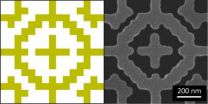Genetic approach helps design broadband metamaterial
2014-05-05
(Press-News.org) A specially formed material that can provide custom broadband absorption in the infrared can be identified and manufactured using "genetic algorithms," according to Penn State engineers, who say these metamaterials can shield objects from view by infrared sensors, protect instruments and be manufactured to cover a variety of wavelengths.
"The metamaterial has a high absorption over broad bandwidth," said Jeremy A. Bossard, postdoctoral fellow in electrical engineering. "Other screens have been developed for a narrow bandwidth, but this is the first that can cover a super-octave bandwidth in the infrared spectrum."
Having a broader bandwidth means that one material can protect against electromagnetic radiation over a wide range of wavelengths, making the material more useful. The researchers looked at silver, gold and palladium, but found that palladium provided better bandwidth coverage. This new metamaterial is actually made of layers on a silicon substrate or base. The first layer is palladium, followed by a polyimide layer. On top of this plastic layer is a palladium screen layer. The screen has elaborate, complicated cutouts -- sub wavelength geometry -- that serve to block the various wavelengths. A polyimide layer caps the whole absorber.
"As long as the properly designed pattern in the screen is much smaller than the wavelength, the material can work effectively as an absorber," said Lan Lin, graduate student in electrical engineering. "It can also absorb 90 percent of the infrared radiation that comes in at up to a 55 degree angle to the screen."
To design the necessary screen for this metamaterial, the researchers used a genetic algorithm. They described the screen pattern by a series of zeros and ones -- a chromosome -- and let the algorithm randomly select patterns to create an initial population of candidate designs. The algorithm then tested the patterns and eliminated all but the best. The best patterns were then randomly tweaked for the second generation. Again the algorithm discarded the worst and kept the best. After a number of generations the good patterns met and even exceeded the design goals. Along the way the best pattern from each generation was retained. They report their results in a recent issue of ACS Nano.
"We wouldn't be able to get an octave bandwidth coverage without the genetic algorithm," said Bossard. "In the past, researchers have tried to cover the bandwidth using multiple layers, but multiple layers were difficult to manufacture and register properly."
This evolved metamaterial can be easily manufactured because it is simply layers of metal or plastic that do not need complex alignment. The clear cap of polyimide serves to protect the screen, but also helps reduce any impedance mismatch that might occur when the wave moves from the air into the device.
"Genetic algorithms are used in electromagnetics, but we are at the forefront of using this method to design metamaterials," said Bossard.
INFORMATION:
Other researchers on this project included Seokho Yun, former postdoctoral fellow in electrical engineering, Liu Liu, graduate student in electrical engineering, Douglas H. Werner, McCain Chair Professor of Electrical Engineering, and Theresa Meyer, Distinguished Professor of Electrical Engineering and Materials Science and Engineering, all at Penn State.
The National Science Foundation supported this work.
ELSE PRESS RELEASES FROM THIS DATE:
Domestic violence victims more likely to take up smoking
2014-05-05
One third of women around the world have experienced physical or sexual violence at the hands of their intimate partners with consequences from post-traumatic stress disorder, anxiety, and depression, to sexually transmitted diseases, including HIV. Now, in a new study in 29 low-income and middle-income countries, researchers at Columbia University's Mailman School of Public Health have identified yet another serious health risk associated with intimate partner violence (IPV): smoking.
The researchers examined the association between IPV and smoking among 231,892 women ...
Soy sauce molecule may unlock drug therapy for HIV patients
2014-05-05
COLUMBIA, Mo. – For HIV patients being treated with anti-AIDS medications, resistance to drug therapy regimens is commonplace. Often, patients develop resistance to first-line drug therapies, such as Tenofovir, and are forced to adopt more potent medications. Virologists at the University of Missouri now are testing the next generation of medications that stop HIV from spreading, and are using a molecule related to flavor enhancers found in soy sauce, to develop compounds that are more potent than Tenofovir.
"Patients who are treated for HIV infections with Tenofovir, ...
Terahertz imaging on the cheap
2014-05-05
Terahertz imaging, which is already familiar from airport security checkpoints, has a number of other promising applications — from explosives detection to collision avoidance in cars. Like sonar or radar, terahertz imaging produces an image by comparing measurements across an array of sensors. Those arrays have to be very dense, since the distance between sensors is proportional to wavelength.
In the latest issue of IEEE Transactions on Antennas and Propagation, researchers in MIT's Research Laboratory for Electronics describe a new technique that could reduce the number ...
History to blame for slow crop taming: Study
2014-05-05
It's been about 10,000 years since our ancestors began farming, but crop domestication has taken much longer than expected – a delay caused less by genetics and more by culture and history, according to a new study co-authored by University of Guelph researchers.
The new paper digs at the roots not just of crop domestication but of civilization itself, says plant agriculture professor Lewis Lukens. "How did humans get food? Without domestication – without food – it's hard for populations to settle down," he said. "Domestication was the key for all subsequent human civilization."
The ...
Spotting a famous face in the crowd
2014-05-05
People can only recognize two faces in a crowd at a time – even if the faces belong to famous people. So says Volker Thoma of the University of East London in the UK in an article which sheds light on people's ability to process faces, published in Springer's journal Psychonomic Bulletin & Review. The findings have relevance to giving eye-witness testimony or for neuropsychological rehabilitation.
Thoma set up two experiments in which participants were asked to identify a famous politician such as Tony Blair and Bill Clinton or pop stars such as Mick Jagger and Robbie ...
Virtual patients, medical records and sleep queries may help reduce suicide
2014-05-05
AUGUSTA, Ga. - A virtual patient, the electronic medical record, and questions about how well patients sleep appear effective new tools in recognizing suicide risk, researchers say.
A fourth – and perhaps more powerful – tool against suicide is the comfort level of caregivers and family members in talking openly about it, said Dr. W. Vaughn McCall, Chairman of the Department of Psychiatry and Health Behavior at the Medical College of Georgia at Georgia Regents University.
Suicide is among the top 10 causes of death in the United States for every group age 10 and older, ...
Light-sensitive 'eyes' in plants
2014-05-05
Most plants try to turn towards the sun. Scientists from the University of Gothenburg have worked with Finnish colleagues to understand how light-sensitive proteins in plant cells change when they discover light. The results have been published in the most recent issue of Nature.
The family of proteins involved is known as the "phytochrome" family, and these proteins are found in all plant leaves. These proteins detect the presence of light and inform the cell whether it is day or night, or whether the plant is in the shade or the sun.
"You can think of them as the ...
Study reveals potentially unnecessary radiation after suspected sports-related injury
2014-05-05
VANCOUVER, BRITISH COLUMBIA – A new study of Utah youth with suspected sports-related head injuries found that emergency room visits for children with sports-related head injuries have increased since the state's concussion law passed in 2011, along with a rise in head CT scans -- leading to potentially unnecessary radiation exposure.
The results were announced at the Pediatric Academic Societies conference in Vancouver, British Columbia in May by William McDonnell, M.D., J.D., associate professor of pediatrics at the University of Utah.
The study, completed by McDonnell ...
New research explores how smoking while pregnant leads to other diseases
2014-05-05
VANCOUVER, BRITISH COLUMBIA – While many parents-to-be are aware that the health of their baby starts before they've actually arrived into the world, recent research reveals that "harm" (i.e., tobacco smoke, dirty air, poor nutrition, even preeclampsia) may not present itself disease-wise until well into adulthood or when a second harmful "hit" triggers the individual's susceptibility.
The results were announced at the Pediatric Academic Societies conference in Vancouver, British Columbia in May by Lisa Joss-Moore, Ph.D., University of Utah Department of Pediatrics. ...
Uncorking East Antarctica yields unstoppable sea-level rise
2014-05-05
The melting of a rather small ice volume on East Antarctica's shore could trigger a persistent ice discharge into the ocean, resulting in unstoppable sea-level rise for thousands of years to come. This is shown in a study now published in Nature Climate Change by scientists from the Potsdam Institute for Climate Impact Research (PIK). The findings are based on computer simulations of the Antarctic ice flow using improved data of the ground profile underneath the ice sheet.
"East Antarctica's Wilkes Basin is like a bottle on a slant," says lead-author Matthias Mengel, ...





